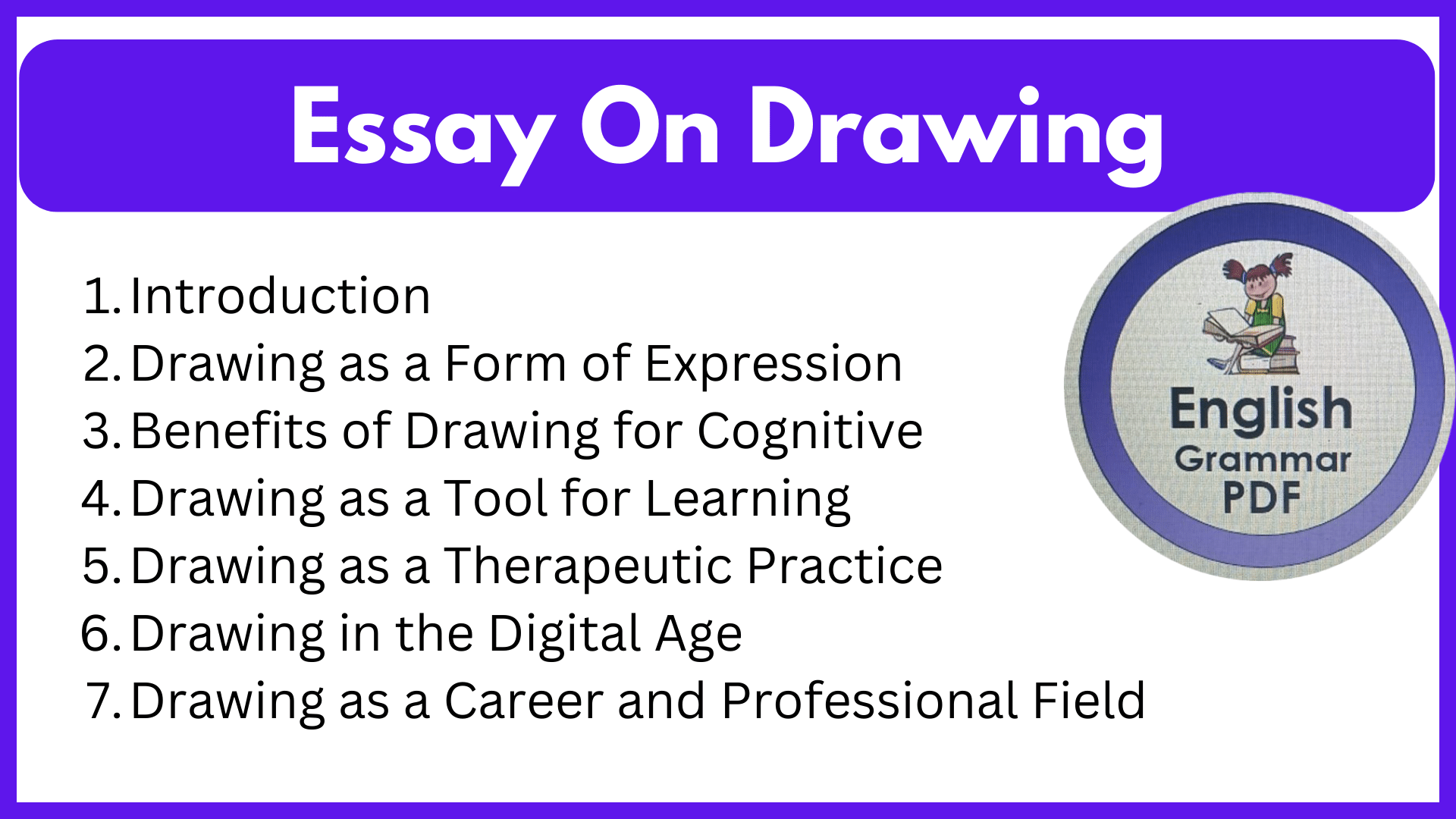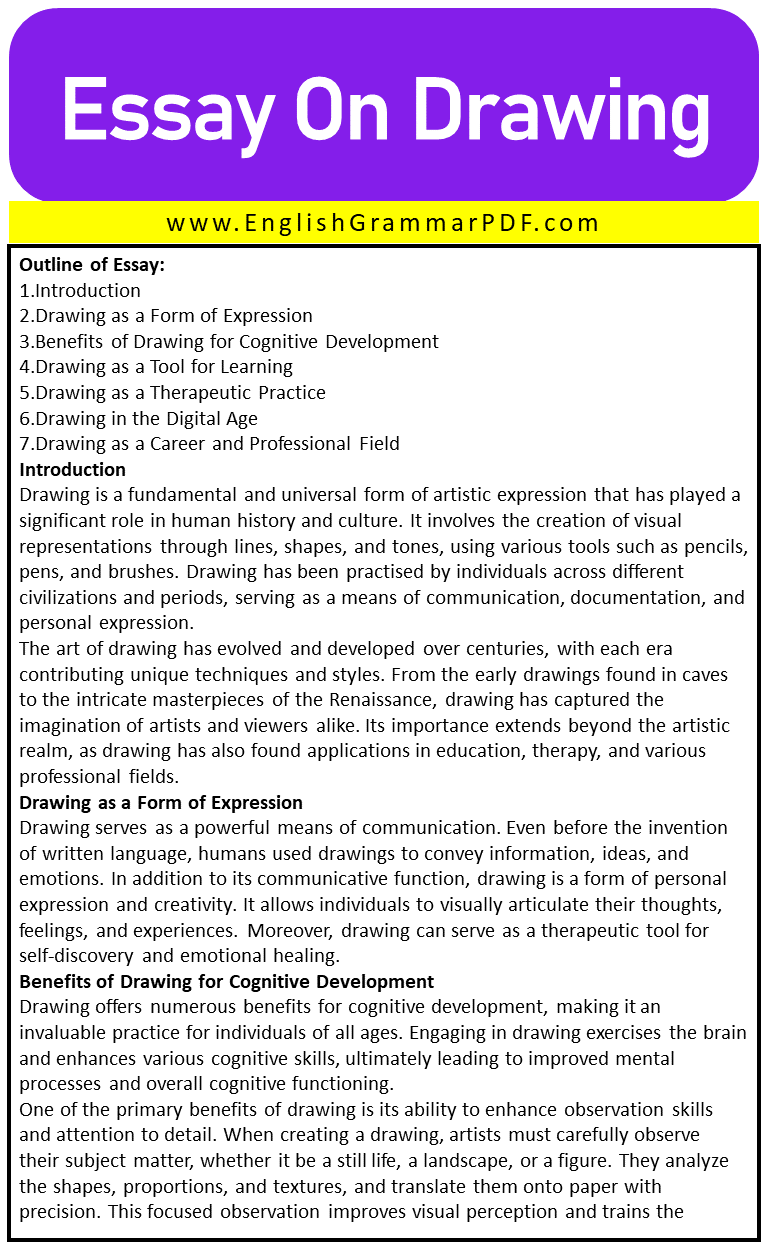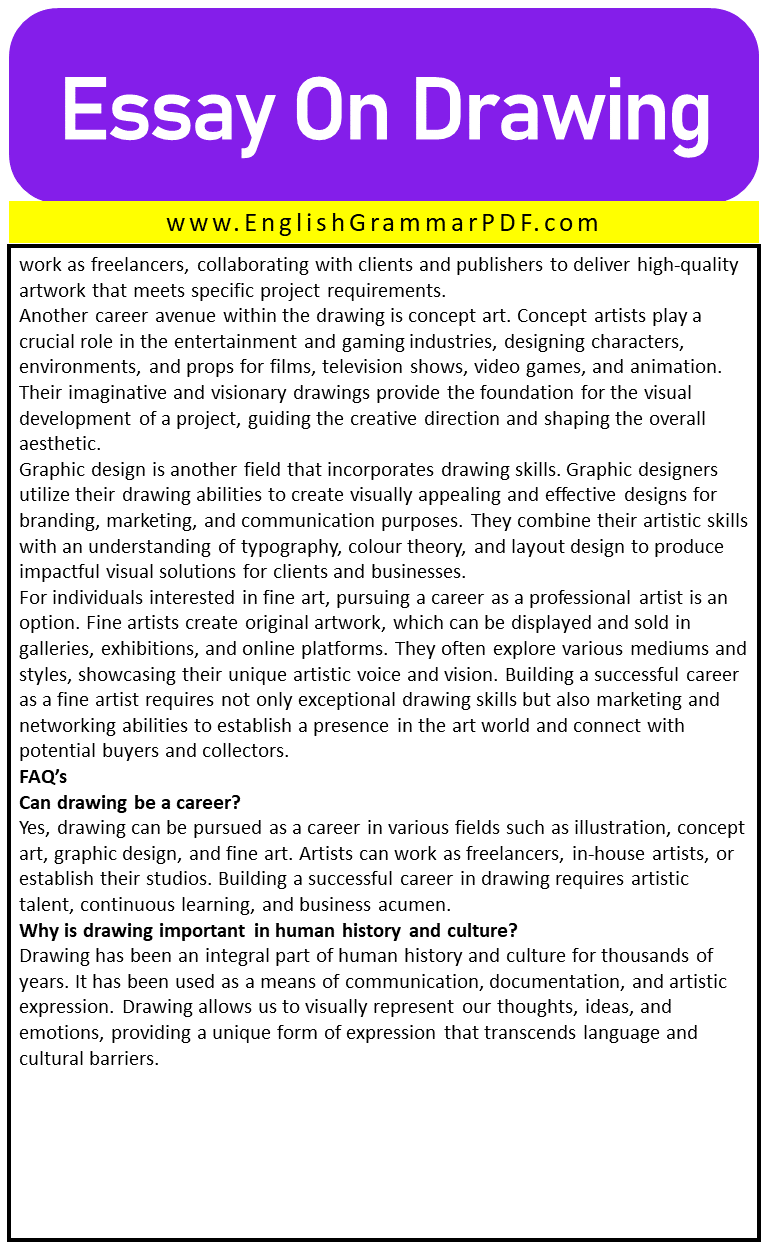Essay On Drawing
Outline of Essay:
- Introduction
- Drawing as a Form of Expression
- Benefits of Drawing for Cognitive Development
- Drawing as a Tool for Learning
- Drawing as a Therapeutic Practice
- Drawing in the Digital Age
- Drawing as a Career and Professional Field
Introduction
Drawing is a fundamental and universal form of artistic expression that has played a significant role in human history and culture. It involves the creation of visual representations through lines, shapes, and tones, using various tools such as pencils, pens, and brushes. Drawing has been practised by individuals across different civilizations and periods, serving as a means of communication, documentation, and personal expression.
The art of drawing has evolved and developed over centuries, with each era contributing unique techniques and styles. From the early drawings found in caves to the intricate masterpieces of the Renaissance, drawing has captured the imagination of artists and viewers alike. Its importance extends beyond the artistic realm, as drawing has also found applications in education, therapy, and various professional fields.
Drawing as a Form of Expression
Drawing serves as a powerful means of communication. Even before the invention of written language, humans used drawings to convey information, ideas, and emotions. In addition to its communicative function, drawing is a form of personal expression and creativity. It allows individuals to visually articulate their thoughts, feelings, and experiences. Moreover, drawing can serve as a therapeutic tool for self-discovery and emotional healing.
Benefits of Drawing for Cognitive Development
Drawing offers numerous benefits for cognitive development, making it an invaluable practice for individuals of all ages. Engaging in drawing exercises the brain and enhances various cognitive skills, ultimately leading to improved mental processes and overall cognitive functioning.
One of the primary benefits of drawing is its ability to enhance observation skills and attention to detail. When creating a drawing, artists must carefully observe their subject matter, whether it be a still life, a landscape, or a figure. They analyze the shapes, proportions, and textures, and translate them onto paper with precision. This focused observation improves visual perception and trains the brain to pay attention to intricate details in the surrounding environment. The ability to notice fine details not only enhances the quality of artwork but also carries over to daily life, enabling individuals to be more observant and attentive to their surroundings.
Drawing also plays a crucial role in developing spatial awareness and hand-eye coordination. Artists must accurately represent the three-dimensional world on a two-dimensional surface, requiring them to understand and depict spatial relationships. This practice strengthens the brain’s spatial reasoning abilities, which are essential in activities such as navigation, problem-solving, and understanding complex structures. Moreover, drawing involves the coordination between the eyes and the hand, as artists use their visual perception to guide the movements of their hands. This coordination not only enhances fine motor skills but also strengthens the neural connections between visual processing and motor control areas of the brain.
Another cognitive benefit of drawing is the fostering of problem-solving skills and critical thinking. When creating a drawing, artists face numerous decisions, such as composition, shading techniques, and colour choices. They must analyze the visual elements and make informed choices to achieve the desired result. This process requires critical thinking, as artists evaluate various options, consider the implications of their choices, and make adjustments accordingly. Drawing challenges individuals to think creatively and problem-solve, stimulating the brain’s capacity for divergent thinking and developing a flexible mindset.
Drawing as a Tool for Learning
Drawing can be a valuable visual aid in education. It helps students better understand and remember complex concepts by creating visual representations that reinforce learning. Through drawing, learners can organize information, make connections, and engage in active learning. It is particularly effective in subjects such as science, geography, and history, where visual representations can clarify abstract or complex ideas.
Drawing as a Therapeutic Practice
Art therapy utilizes drawing as a therapeutic practice to promote healing and personal growth. Drawing provides a non-verbal outlet for self-expression and emotional release. It can help individuals explore and communicate their feelings, reduce stress and anxiety, and develop coping mechanisms. Numerous case studies and examples demonstrate the positive impact of drawing as a therapeutic tool.
Drawing in the Digital Age
Drawing has undergone a significant transformation in the digital age, thanks to advancements in technology and the emergence of digital drawing tools. The digital medium has revolutionized the way artists create, share, and interact with their artwork, opening up new possibilities and expanding the creative landscape.
One of the most notable impacts of technology on drawing is the increased accessibility it offers. Digital drawing tools have made the art form more accessible to a wider range of individuals. Traditional art supplies can be expensive and require dedicated studio space, but digital drawing can be pursued with minimal equipment—a digital tablet and a stylus. This accessibility has democratized the art form, allowing aspiring artists to explore their creativity and hone their skills without financial barriers.
Digital drawing tools also provide artists with greater versatility and flexibility. With a wide array of digital brushes, colours, and effects, artists can experiment with various styles and techniques. Digital software allows for easy manipulation and correction, enabling artists to undo mistakes and make precise adjustments. Furthermore, artists can easily share their work online, reaching a global audience and receiving feedback from other artists and art enthusiasts. The ability to connect and engage with a community of artists fosters inspiration, learning, and growth.
The blending of traditional and digital drawing techniques is another significant aspect of drawing in the digital age. Many artists now combine traditional art mediums with digital enhancements, merging the tactile experience of traditional drawing with the advantages of digital tools. For instance, artists may create a traditional pencil sketch and then scan it into the computer to add colour and effects digitally. This blending of mediums allows for greater experimentation and the creation of unique and hybrid artworks.
However, it is worth noting that the transition to the digital medium does not diminish the importance of traditional drawing skills. The foundational principles of drawing, such as observation, composition, and perspective, remain essential regardless of the medium. Digital tools are simply another toolset for artists to explore and utilize in their creative practice.
Drawing as a Career and Professional Field
Drawing offers diverse career opportunities and serves as a professional field for individuals with a passion for artistic expression. While pursuing a career in drawing may seem unconventional to some, it is a viable and fulfilling path for those who possess talent, creativity, and dedication to their craft.
One of the primary career paths in drawing is illustration. Illustrators create visual representations for various industries and purposes, including books, magazines, advertising, and digital media. They can convey complex ideas and narratives through their drawings, bringing stories and concepts to life. Illustrators often work as freelancers, collaborating with clients and publishers to deliver high-quality artwork that meets specific project requirements.
Another career avenue within the drawing is concept art. Concept artists play a crucial role in the entertainment and gaming industries, designing characters, environments, and props for films, television shows, video games, and animation. Their imaginative and visionary drawings provide the foundation for the visual development of a project, guiding the creative direction and shaping the overall aesthetic.
Graphic design is another field that incorporates drawing skills. Graphic designers utilize their drawing abilities to create visually appealing and effective designs for branding, marketing, and communication purposes. They combine their artistic skills with an understanding of typography, colour theory, and layout design to produce impactful visual solutions for clients and businesses.
For individuals interested in fine art, pursuing a career as a professional artist is an option. Fine artists create original artwork, which can be displayed and sold in galleries, exhibitions, and online platforms. They often explore various mediums and styles, showcasing their unique artistic voice and vision. Building a successful career as a fine artist requires not only exceptional drawing skills but also marketing and networking abilities to establish a presence in the art world and connect with potential buyers and collectors.
FAQ’s
Can drawing be a career?
Yes, drawing can be pursued as a career in various fields such as illustration, concept art, graphic design, and fine art. Artists can work as freelancers, in-house artists, or establish their studios. Building a successful career in drawing requires artistic talent, continuous learning, and business acumen.
Why is drawing important in human history and culture?
Drawing has been an integral part of human history and culture for thousands of years. It has been used as a means of communication, documentation, and artistic expression. Drawing allows us to visually represent our thoughts, ideas, and emotions, providing a unique form of expression that transcends language and cultural barriers.
Explore More Essays:
1500+ Words Essay On Disrespect
Download the PDF of the Essay:







